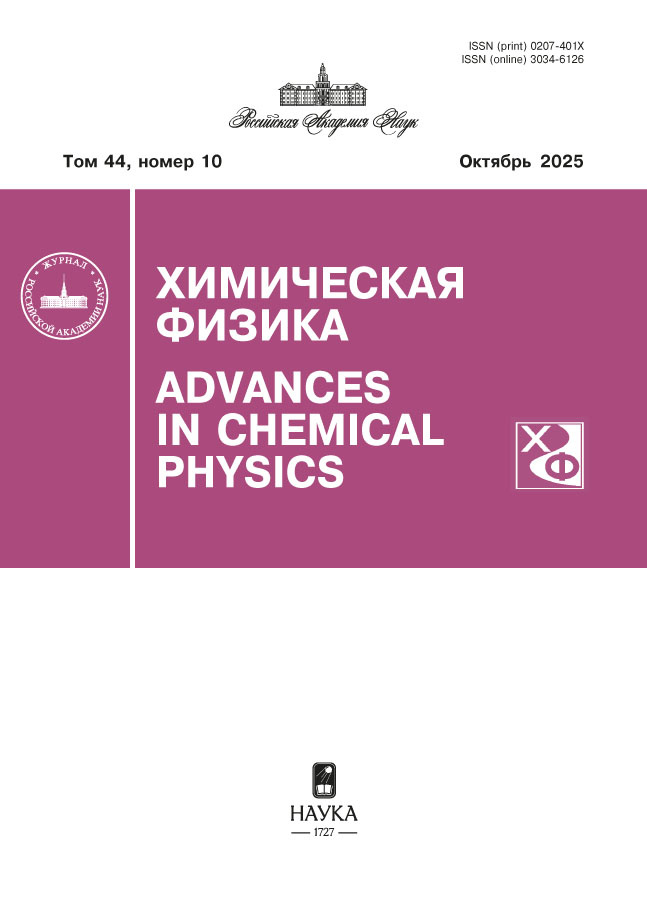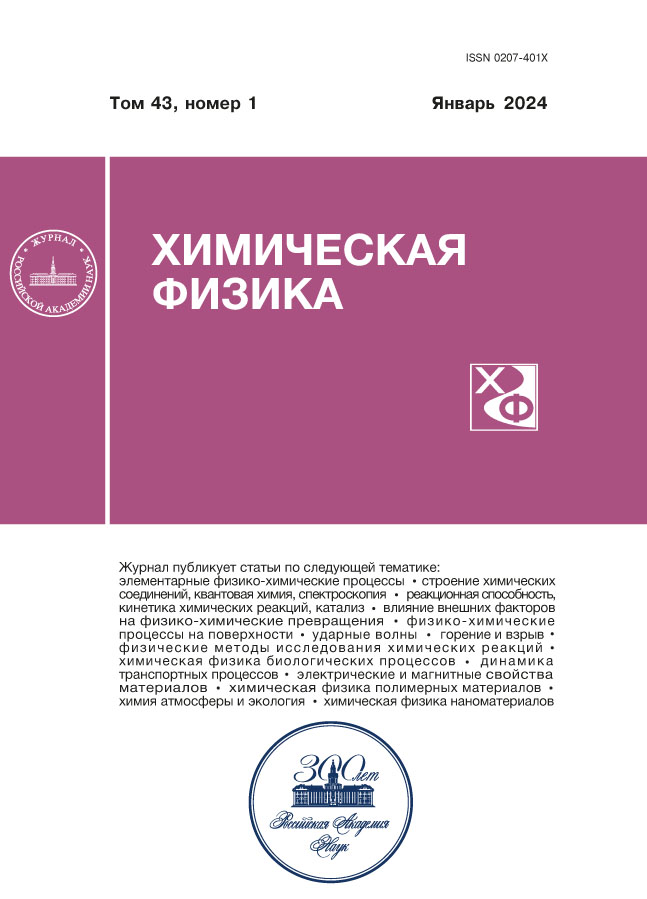Том 43, № 1 (2024)
Элементарные физико-химические процессы
Метод расщепления поляризационных координат в задаче моделирования сверхбыстрого многостадийного переноса электрона в недебаевской среде
Аннотация
Разработан метод построения пространства состояний среды в реакциях сверхбыстрого многостадийного внутримолекулярного переноса электрона в средах с несколькими временами релаксации. Метод основан на расщеплении поляризационных координат на релаксационные компоненты и является обобщением двух разработанных ранее подходов, применяемых для описания многостадийных реакций и учета многокомпонентной релаксации. В рамках предложенной общей схемы рассмотрена задача о переносе заряда в модельной трехцентровой молекулярной системе в среде с двухкомпонентной функцией релаксации, описан алгоритм построения диабатических поверхностей свободной энергии электронных состояний системы, записана система уравнений для эволюции функций распределения частиц в этих состояниях. Показано, что полученные в рамках обобщенной модели результаты воспроизводят известные решения в частных случаях.
 3-12
3-12


Строение химических соединений, квантовая химия, спектроскопия
Квантовохимические расчеты энтальпии образования изомерных 5/6/5-трициклических производных тетразинов, аннелированных нитротриазолами
Аннотация
Проведена оценка термохимических свойств шести новых высокоэнергетических изомерных 5/6/5-трициклических структур, представляющих собой 1,2,3,4- или 1,2,4,5-тетразины, аннелированные с парой 1H-1,2,4-, 4H-1,2,4- или 1H-1,2,3-триазолов, общей формулы C4N10O4. Определены значения энтальпии образования этих соединений в газовой фазе с использованием различных квантовохимических методов расчета: G4, G4MP2, ωB97XD/aug-cc-pVTZ, CBS-APNO, CBS-QB3, CBS-4M, B3LYP/6-311+G(2d,p), M062X/6-311+G(2d,p). Выполнен анализ результатов вычислений, полученных методами атомизации и реакций образования соединений из простых веществ в стандартных условиях. Рассчитаны ИК-спектры поглощения, структурные параметры и смещения атомов для наиболее интенсивных колебаний соединений.
 13-23
13-23


Кинетика и механизм химических реакций, катализ
Влияние органических ингибиторов коррозии на кинетику катодной реакции выделения водорода на стали в растворе серной кислоты
Аннотация
Разработан метод построения пространства состояний среды в реакциях сверхбыстрого многостадийного внутримолекулярного переноса электрона в средах с несколькими временами релаксации. Метод основан на расщеплении поляризационных координат на релаксационные компоненты и является обобщением двух разработанных ранее подходов, применяемых для описания многостадийных реакций и учета многокомпонентной релаксации. В рамках предложенной общей схемы рассмотрена задача о переносе заряда в модельной трехцентровой молекулярной системе в среде с двухкомпонентной функцией релаксации, описан алгоритм построения диабатических поверхностей свободной энергии электронных состояний системы, записана система уравнений для эволюции функций распределения частиц в этих состояниях. Показано, что полученные в рамках обобщенной модели результаты воспроизводят известные решения в частных случаях.
 24-38
24-38


Кинетическое моделирование влияния условий сопряженного окисления пропана и этилена на выход пропилена
Аннотация
Исследование окисления пропан-этиленовых смесей методом численного кинетического моделирования позволило установить, что в температурном интервале 400–600 oC при увеличении конверсии пропана с ростом температуры селективность образования пропилена проходит через максимум, положение которого зависит от концентрации этилена в исходной смеси. Увеличение концентрации этилена в исходной смеси приводит к сокращению расхода пропана и увеличению селективности образования пропилена. Определены условия, при которых этилен, вводимый в исходную смесь, не расходуется в ходе процесса, поэтому формально в этом случае его можно рассматривать как катализатор, а процесс окисления пропана как протекающий в псевдокаталитическом режиме.
 39-46
39-46


Влияние саморазогрева на кинетику экзотермической реакции в изотермических условиях
Аннотация
Проведены оценки, показывающие, что при протекании экзотермической реакции в изотермической среде (в термостате) возникают саморазогревы, величины которых определяются конкуренцией процессов теплоприхода и теплоотвода. Получены соотношения, позволяющие оценить отклонения наблюдаемых величин кинетических параметров от истинных значений и выявить влияние различных параметров на эти отклонения.
 47-51
47-51


Кинетические особенности окисления метиллинолеата в мицеллах додецилсульфата натрия
Аннотация
Комбинация кинетических и физико-химических методов с компьютерным моделированием позволила получить новую информацию по окислению метиллинолеата (LH) в мицеллах додецилсульфата натрия при 310 K. Динамика процесса связана с характером изменения объема мицеллярной фазы (Vмиц). Постепенное увеличение Vмиц приводит к уменьшению концентрации субстрата окисления. Это изменение происходит не только за счет химических реакций, но и за счет изменения объема микрореактора, в котором происходит химическое превращение. Накопление гидропероксидов внутри тех мицелл, в которых происходит окисление LH, приводит к трансформации их структуры и образованию смешанных мицелл. Кинетический анализ показывает, что обрыв цепей может осуществляться по смешанному механизму. Порядок реакции по инициатору варьируется от 0.61 до 0.71. Ведущие цепи окисления пероксирадикалы (LO2•) участвуют как в квадратичном, так и в линейном обрыве. Линейный обрыв реализуется с участием гидропероксильных радикалов (HO2•). Образование HO2• обусловлено реакцией LO2• → Продукт + HO2•, происходящей в органической фазе. Образующиеся радикалы НO2• выходят в водную фазу, где скорость их диспропорционирования очень низка. Формально это фиксируется как линейный обрыв цепи.
 52-59
52-59


Горение, взрыв и ударные волны
Термохимические свойства тринитрометил-1,3,5-триазинов
Аннотация
Калориметрическим методом определены энтальпии сгорания и энтальпии образования трех тринитрометильных производных 1,3,5-триазина. Полученные данные могут быть полезны для расчетов энергетических возможностей родственных соединений методом замены функциональных групп. В качестве примера рассчитаны детонационные характеристики высокоэнергоемкого трис(тринитрометил)-1,3,5-триазина.
 60-65
60-65


Пропаргилзамещенные производные фуразаноазепинов: синтез, структура, энтальпия образования, баллистическая эффективность
Аннотация
Впервые синтезированы 7-пропаргил-7Н-дифуразано[3,4-b :3′,4′-f]фуроксано[3″,4″-d]азепин (Az(O)Prg) и 7-пропаргил-7Н-трифуразано[3,4-b :3′,4′-d :3″,4″-f]азепин (AzPrg) как потенциальные диспергаторы твердых топлив для газогенерирующих двигателей; определена их молекулярная структура, энтальпии сгорания и образования; оценена относительная дальность полета летательного аппарата при использовании Az(O)Prg и AzPrg в качестве диспергаторов твердого топлива.
 66-78
66-78


Зависимость тротилового эквивалента подводного взрыва от содержания гидрида алюминия в энергетическом материале
Аннотация
Полученные результаты продемонстрировали возможность существенного повышения теплоты взрыва (ТВ) и тротилового эквивалента (ТЭ) по энергии ударной волны при подводном взрыве за счет добавления алюминия (Al) и гидрида алюминия (AlH3) к взрывчатому веществу (ВВ). Несмотря на то, что составы с AlH3 уступают по ТВ алюминийсодержащим аналогам, по количеству молей газообразных продуктов преимущество принадлежит композициям с AlH3. Замена Al на AlH3 в смеси с ВВ приводит к повышению массовых значений ТЭ. Последнее особенно заметно в случае, когда базовое ВВ имеет положительный кислородный баланс. Однако составы с AlH3 проигрывают композициям с Al по величине объемного эквивалента.
 79-83
79-83


ДИНАМИКА ФАЗОВЫХ ПЕРЕХОДОВ
Механизм фазообразования Sm2MoO6 из механически активированной смеси оксидов
Аннотация
Методом дифференциальной сканирующей калориметрии (ДСК) в атмосфере кислорода исследован механизм фазообразования из исходной либо механически активированной смеси оксидов Sm2O3 + MoO3. Показано, что в двух этих случаях реализуются различные механизмы синтеза оксимолибдата самария. В результате механохимического воздействия при комнатной температуре образуется смесь наноразмерных частиц Sm2(MoO4)3 и Sm2O3. При ее нагревании на первом этапе происходит кристаллизация соединения Sm2(MoO4)3, взаимодействие которого с Sm2O3 на втором этапе при 900 °С приводит к образованию оксимолибдата Sm2MoO6 со структурой шеелита, и этот структурный тип устойчив вплоть до 1400 °С. Кинетический эксперимент в ДСК-ячейке дает видимость сходства механизма фазообразования со снижением основных экзоэффектов на 70 °С для механически активированной смеси оксидов. При этом исследование механизма фазообразования методом изотермической выдержки при различных температурах выявляет основные преимущества синтеза керамики из активированной оксидной смеси.
Исследована общая проводимость Sm2MoO6 со структурой шеелита на воздухе, которая оказалась электронной p-типа (1 · 10−6 См/см при 600 °С).
 84-91
84-91


Химическая физика полимерных материалов
Влияние направленного электрического поля на особенности структурных формирований в пленках бутадиен-нитрильного каучука
Аннотация
Исследовано влияние направленности постоянного электрического поля на свойства и структурные особенности пленок бутадиен-нитрильного синтетического каучука (БНКС), сформированных на медных подложках из раствора в хлороформе. Показано, что модификация свойств, связанных со структурными преобразованиями в процессе формирования пленок эластомера, происходит в основном на отрицательном электроде — катоде, когда силовые линии электрического поля направлены к поверхности электрода. Методом дифференциальной сканирующей калориметрии показаны структурные различия пленок, сформированных вне и в присутствии электрических полей. Сформированные в полях пленки обладают электротехническими характеристиками, отличными от аналогичных характеристик пленок, сформированных вне поля. Методом спектроскопии комбинационного рассеяния подтверждено протекание структурирования и циклизации молекул БНКС на поверхности пленки, сформированной на катоде.
 92-101
92-101


Химическая физика наноматериалов
Влияние способа формирования композитов ZnO–In2O3 на их структурные характеристики и проводимость
Аннотация
Композиты на основе оксида индия, содержащие разные количества оксида цинка, синтезированы гидротермальным способом и методом импрегнирования. Исследованы фазовый состав, структура и удельная поверхность полученных композитов различными физико-химическими методами и проведено их сравнение электрофизических свойств. Показано, что способ формирования оказывает значительное влияние на структурные характеристики композитов, что в свою очередь, приводит к реализации различных механизмов проводимости.
 102-108
102-108













